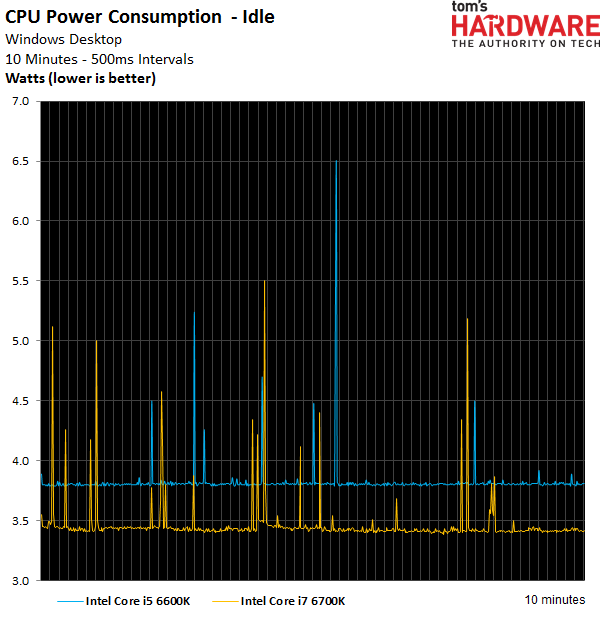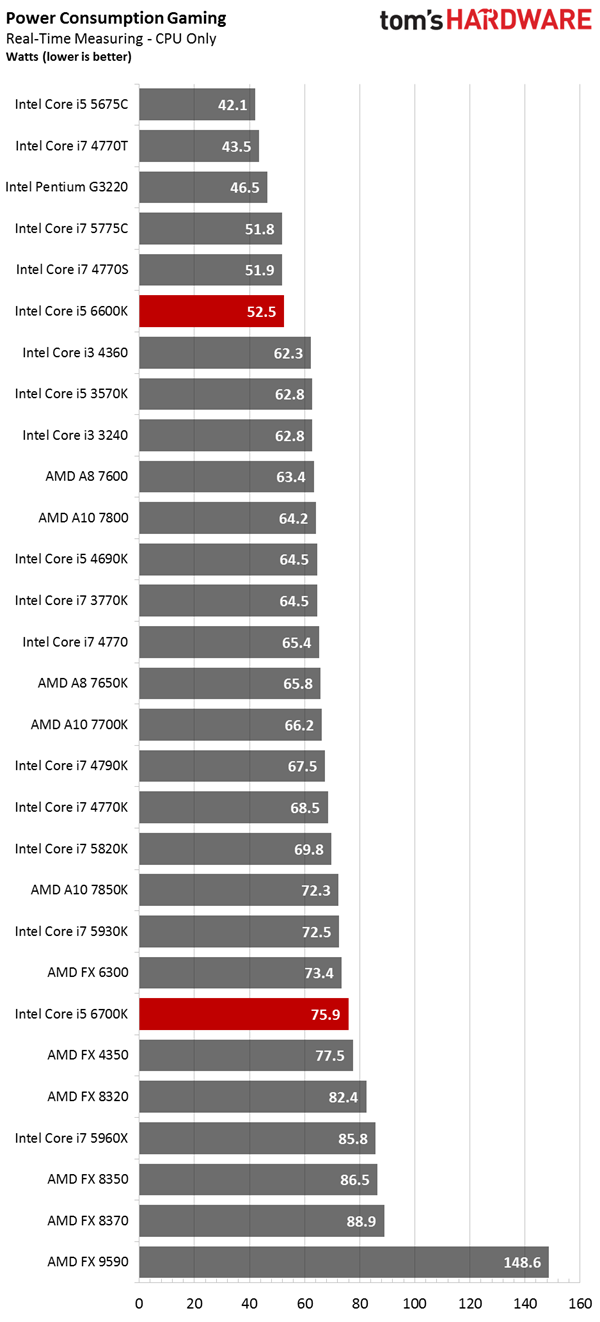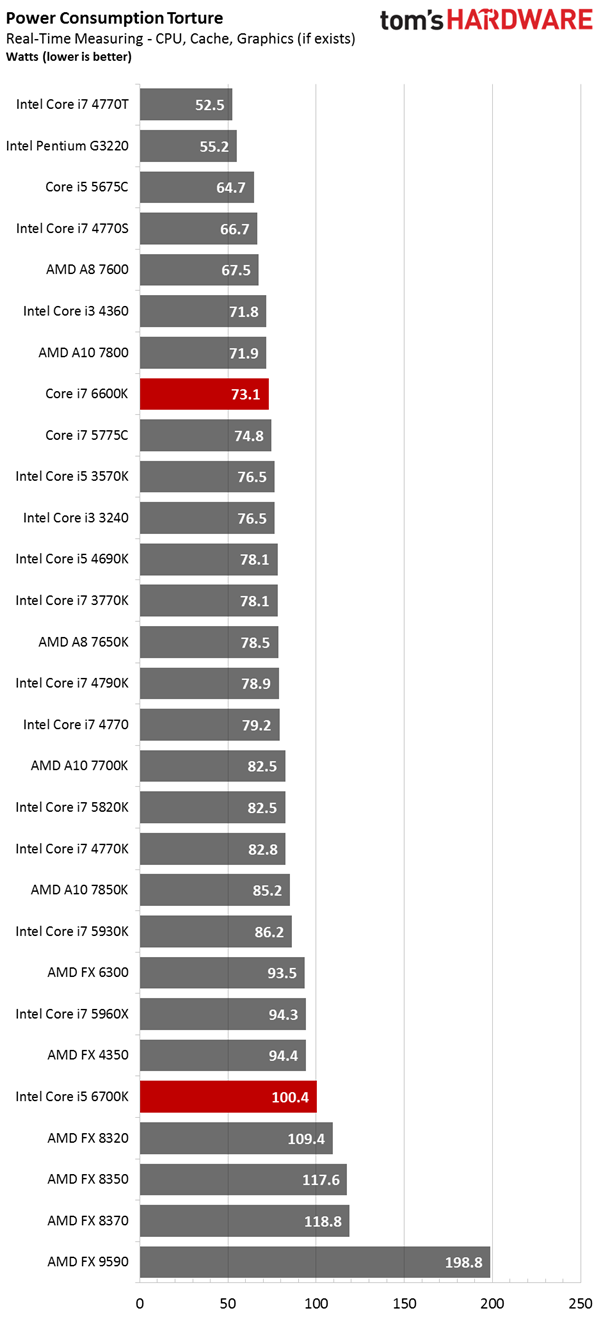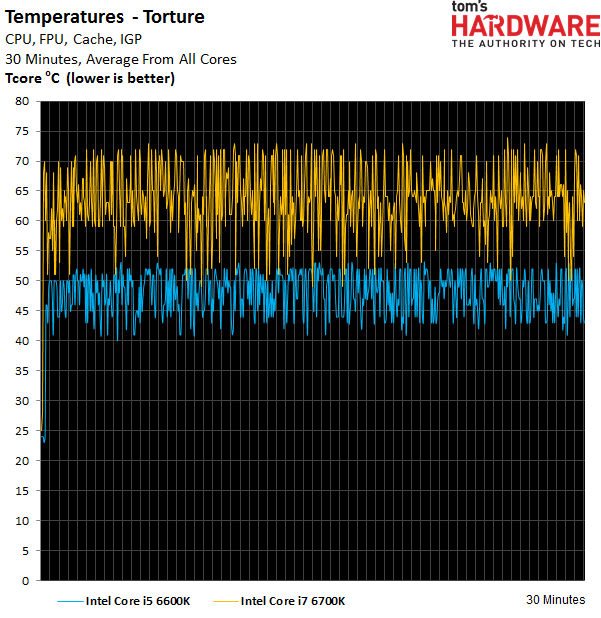Skylake: Intel's Core i7-6700K And i5-6600K
Intel gave us an early look at the Core i7-6700K, i5-6600K and Z170 chipset two weeks ahead of IDF and the unveiling of Skylake's architectural details.
Power And Temperature
In response to feedback from our Broadwell coverage, we're increasing the benchmark run time from one to 10 minutes, and setting the graph's time interval to 500ms, which seems sufficient to achieve meaningful averages.
Idle Power Consumption
The two new CPUs consume even less power than their Broadwell counterparts. With this small decrease, they end up under 4W with their IGPs active and trucking along at 800MHz. This is a great result. In fact, it’s the best we've seen from any CPU.
Gaming Power Consumption
Let’s think back to our GTA V test for a moment. In order to generate measurements that are easy to reproduce, we rendered a scene using the integrated recorder that takes a lot of graphics power at a resolution of 720p for the IGP and 1080p for Nvidia’s GeForce GTX 980.
The combination of GeForce GTX 980 and Core i5-6600K yields an average power consumption of 53W. This is comparable to what we measured for the i7-5775C a couple of months ago. Surprisingly, Intel’s Core i7-6700K comes in 23W above this number, landing at 76W. Our i5-6600K test sample might be great, or our i7-6700K particularly bad, depending on how you want to look at it. At the very least, it demonstrates the variability between CPUs in the same family, though we also have to keep in mind that these are engineering samples.
Now we pop out the add-in card and look at power consumption with on-die graphics. Broadwell’s power consumption stays the same in this test, since a host processing bottleneck keeps it there. That's not the case for Skylake. The two new CPUs’ graphics performance are very similar, with a difference of only 2 FPS. The i7-6700K averages 80 FPS, while the i5-6600K almost manages to keep up at 78. However, the i7-6700K’s power consumption is 83W, whereas the i5-6600K consumes just 69W. That's a significant 14W difference.
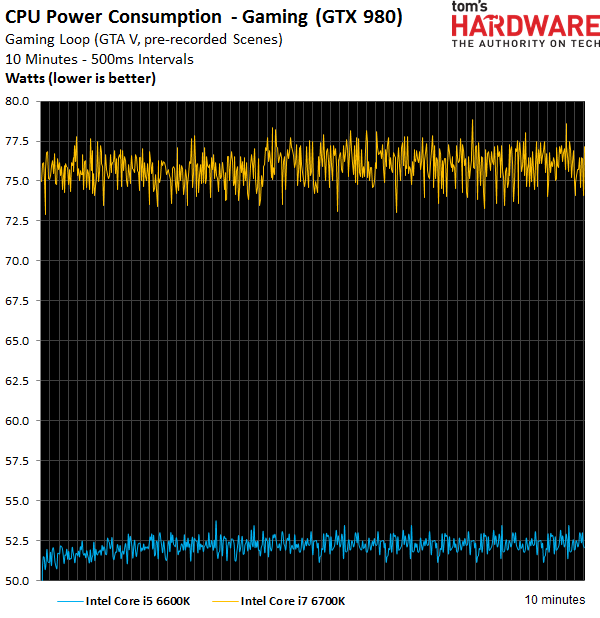
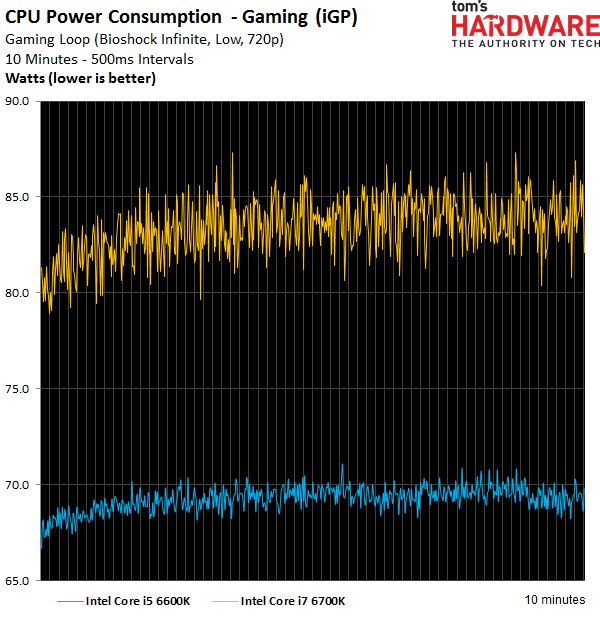
Maximum Power Consumption (Stress Test)
We’re creating the maximum possible CPU load, including its x86 cores, the FPU, the cache and the IGP, and then putting power consumption under a microscope. To better illustrate the outcome, each processor gets its own graph, offering a clearer view of the differences between individual performance and load states.
The Core i5-6600K remains relatively frugal with an average of 73W, whereas the i7-6700K helps itself to a full 100W (a 27W delta). Even though the i7 is Hyper-Threaded, allowing it to be better-utilized, with an average clock rate that's 300MHz higher, our measurement just isn't really acceptable, particularly since it's 5W over the CPU's claimed TDP.
Get Tom's Hardware's best news and in-depth reviews, straight to your inbox.
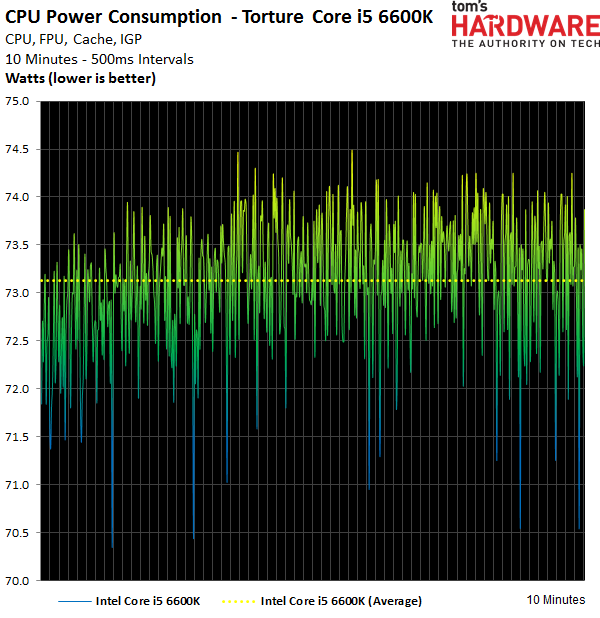
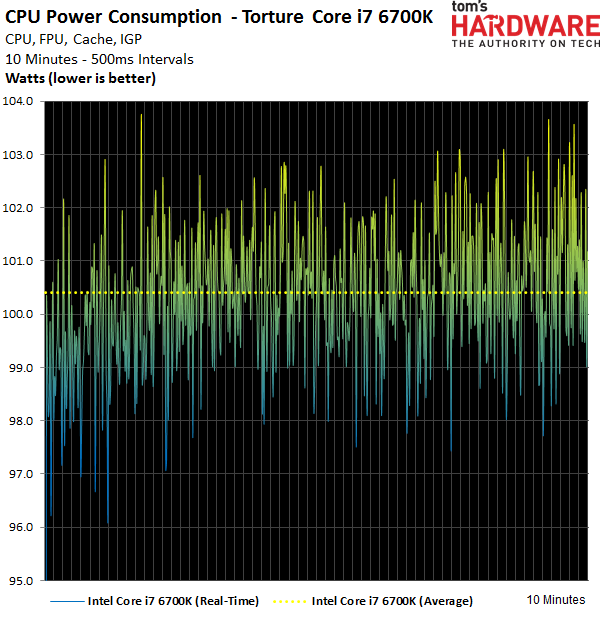
Power Consumption Overview
The picture that emerged from our detailed results is confirmed when the two new processors are compared to other CPUs and APUs.
Unfortunate outliers, such as AMD’s FX-9590 under load and the FX-4350 at idle are pieces of the puzzle. Anyone wondering why a Core i7-5960X looks almost like a low-power CPU in comparison needs to remember that most of Intel's processors are operated right around their sweet spots, whereas AMD’s larger FX models and a few of Intel’s chips are pushed into inefficient territory at their stock frequencies.
We’ve deliberately selected a large number of CPUs for this comparison, covering a wide range of performance and, as a result, power consumption.
The new Skylake processors’ low power consumption at idle immediately jumps out in a positive way. These results represent a substantial improvement.
Intel’s Core i5-6600K scores some major points for the new platform when it comes to gaming with an add-in graphics card, even though Broadwell already set the bar for this very high. Part of the explanation for this result can be found in the fact that integrated graphics draws practically no power in this scenario, whereas the older processors with integrated graphics always had at least some losses. Only the Core i7-6700K sticks out a bit; we’ve already discussed some of the reasons that might be the case.
Under full load, we see a similar picture. A difference of approximately 21W compared to the older Core i7-4790K is too high in our opinion. We’ll try to rerun these numbers after the launch with a retail CPU to see if our results are due to our lab sample and update this article accordingly if it proves necessary.
Let’s compare the two CPUs in a table:
| Header Cell - Column 0 | Intel Core i5-6600K | Intel Core i7-6700K |
|---|---|---|
| Idle without IGP | 3.82W | 3.46W |
| Idle with IGP | 5.96W | 5.62W |
| Gaming without IGP | 52.17W | 75.89W |
| Gaming with IGP | 69.26W | 83.42W |
| Torture with IGP | 73.13W | 100.35W |
Temperatures at Full Load (During the Stress Test)
The Core i5-6600K’s temperature across all cores averages approximately 48 degrees Celsius after 30 minutes, and the i7-6700K ends up at approximately 64 degrees Celsius. Even during peaks, it never surpasses the limit of 73 degrees Celsius.
Due to reader feedback, we reverted back to our reference air CPU cooler, as opposed to the all-in-one water cooling solution. In light of this, these results are certainly decent, even though the i7-6700K’s higher power consumption drives up the temperatures.
The bottom line is that both CPUs can be cooled on air very effectively, which wasn’t really possible with Intel’s slower Core i7-4770K, if it was even just slightly overclocked.

Igor Wallossek wrote a wide variety of hardware articles for Tom's Hardware, with a strong focus on technical analysis and in-depth reviews. His contributions have spanned a broad spectrum of PC components, including GPUs, CPUs, workstations, and PC builds. His insightful articles provide readers with detailed knowledge to make informed decisions in the ever-evolving tech landscape
-
rantoc Yawn... its easy to see that intel have to little competition, they have stagnated in the cpu performance department!Reply -
Vlad Rose What the heck Intel? So, you provide great integrated graphics into Broadwell, then nerf it for Skylake? I guess you had to find a way to help sell your 'paper launch' of Broadwell. I really hope Xen makes you guys wake up; although it more than likely won't.Reply -
Bartendalot At least Skylake HEDT should be powerful. Unless DX12 pulls a rabbit out of a hat, this doesn't look promising for anyone who has Sandy or higher.Reply -
stairmand ReplyStill 4 cores.... Im sticking to my Q6600.
Then you really are missing out, 4 cores or not a current i5 (let alone an i7) will simply destroy the old Q6600 C2Q. It was great in the day but it's very old hat now and the lack of features on the board worse still. -
salgado18 ReplyStill 4 cores.... Im sticking to my Q6600.
You do know that your Q6600 is astronomically slower than Skylake in every single department, right? By your logic, the Phenom II X6 is better than the i7 6700K.
I think you should consider upgrading. You won't regret, promise. -
salgado18 ReplyWhat the heck Intel? So, you provide great integrated graphics into Broadwell, then nerf it for Skylake? I guess you had to find a way to help sell your 'paper launch' of Broadwell. I really hope Xen makes you guys wake up; although it more than likely won't.
Do you mean Shen, from LoL? Or Zen? XD
I believe the cost of the integrated memory chips would make these processors too expensive and niche to be viable products.
-
Lmah Good upgrade for 1st Gen i5/i7 users. Though I think they targeted it at the 2nd Gen i5/i7 users, doesn't seem like a huge improvement for them though.Reply
